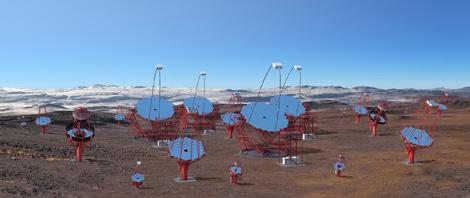Gamma Ray Astrophysics: the Southern CTA Observatory will be built in Chile
The Cherenkov Telescope Array (CTA) Observatory today announced the signing of three agreements to build its southern site in Chile, specifically on ESO lands 11km southeast of the Very Large Telescope (VLT) in the Atacama Desert. CTA will consist of a network of 118 telescopes spread over two sites, one in the Northern Hemisphere and one in the Southern Hemisphere. The CNRS and CEA teams participated in the choice of the location in the Southern Hemisphere and are preparing the instruments for the telescopes. The first gamma observations of the Universe by CTA are expected as early as 2022.

Gamma-ray astronomy bears witness to some of the most violent phenomena in the Universe, such as the explosion of massive stars at the end of their lives (supernovae), the activity of galactic black holes, the fusion of black holes or gamma-ray bursts. By associating it with infrared, visible and X-ray observations, it should lead to a better understanding of the natural “particle accelerators” that are these cosmic “monsters”. Physicists also hope to observe the annihilation of dark matter via the accompanying gamma emission, and thus finally unmask it.
The Chernenkov telescopes, such as Hess in Namibia, Magic in the Canary Islands and Veritas in the United States, detect on the ground the bluish light produced by the interaction of very high energy gamma rays with the atmosphere. In order to cover the entire celestial vault, two arrays of such telescopes must be installed, one in the Northern Hemisphere and the second in the Southern Hemisphere. A total of 100 telescopes, erected specifically for CTA, will make it possible to study the cataclysmic phenomena of the Universe with performances ten times better than those of existing instruments.
French contributions
Scientists from CNRS and CEA, in conjunction with their partners, have developed the NectarCAM camera for 25 medium-sized telescopes (12 metres in diameter). Composed of 1855 highly sensitive photomultipliers, it will be able to record high-energy gamma-ray “events” (from 100 GeV to 10 TeV) at the nanosecond scale (10-9 s). The qualification detector is currently being assembled. It will be tested in Berlin in the first half of 2019 for on-site installation at the end of 2020.
CNRS laboratories are also working on the other two types of telescopes. For the 4 large telescopes (23 metres in diameter) dedicated to low energies (20 to 150 GeV), the CNRS has designed the high mechanical structure as well as the mechatronics and computer system for piloting and control. A prototype of the Schwarzschild-Couder type, a double-reflection telescope with a large field of view, has been designed for the 70 small telescopes (4 metres in diameter) dedicated to high energies (> 5 TeV). CNRS teams and their partners also contribute to the observatory’s data management elements, including the design of the data processing pipeline and tools for their scientific analysis. Finally, CNRS is developing a Raman LIDAR for atmospheric monitoring.
The CEA has designed hexagonal mirror elements, both high-performance and very inexpensive, that will be able to “pave” the mirrors of 12-metre telescopes of average size.
The French laboratories involved are :
- l’Institut de recherche sur les lois fondamentales de l’Univers (CEA-Irfu)
- le Centre de physique des particules de Marseille (CNRS/AMU)
- l’Institut de physique nucléaire d’Orsay (CNRS/Université Paris-Sud)
- le laboratoire « Astroparticule et Cosmologie » (CNRS/CEA/Université Paris Diderot/Observatoire de Paris)
- le Laboratoire d’Annecy de physique des particules (CNRS/Université de Savoie Mont-Blanc)
- le Laboratoire Leprince-Ringuet (CNRS/École Polytechnique)
- le Laboratoire physique nucléaire et hautes énergies (CNRS/Sorbonne Université/Université Paris Diderot)
- le Centre études nucléaires de Bordeaux Gradignan (CNRS/Université de Bordeaux)
- le Laboratoire Univers et particules de Montpellier (CNRS/Université de Montpellier)
- le laboratoire « Galaxies, étoiles, physique, instrumentation » (CNRS/Observatoire de Paris/Université Paris Diderot)
- le Laboratoire Univers et théories (CNRS/Université Paris Diderot/Observatoire de Paris)
- l’Institut de recherche en astrophysique et planétologie (CNRS/UT3 Paul Sabatier)
- l’Institut de planétologie et d’astrophysique de Grenoble (CNRS/Université Grenoble Alpes)
- l’Observatoire de la Côte d’Azur
IRAP Contact
- Jurgen Knodlseder, jurgen.knodlseder@irap.omp.eu






